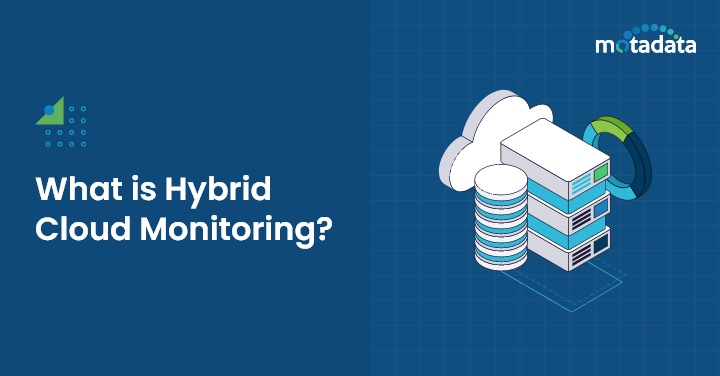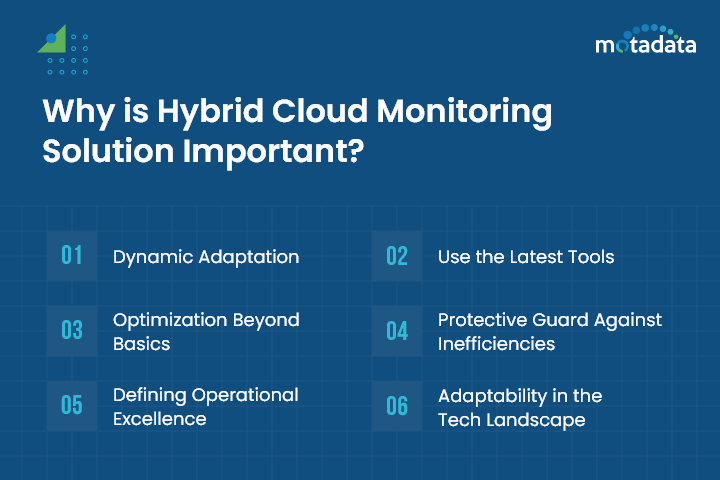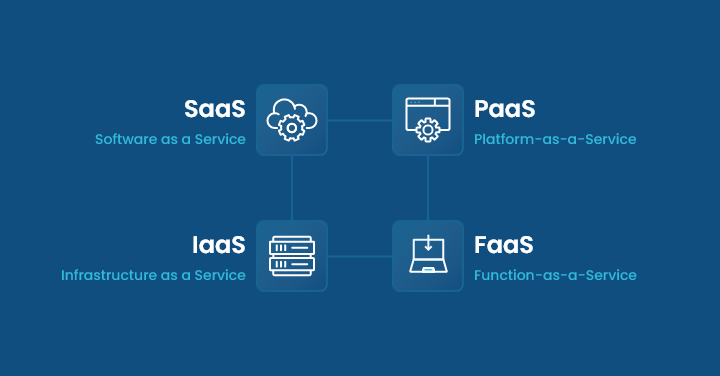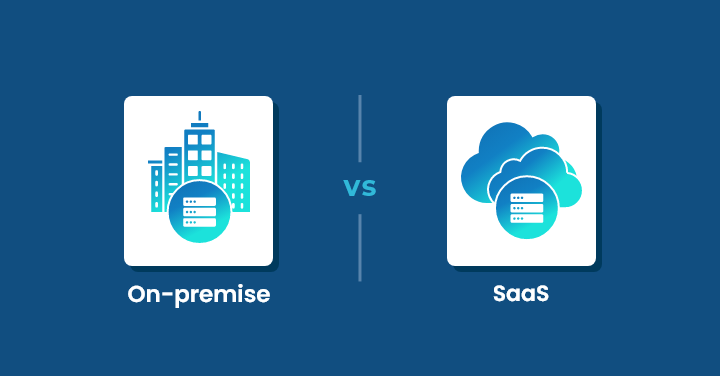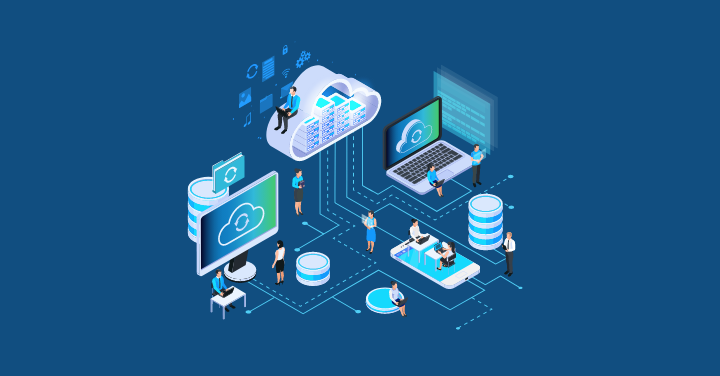In the fast-moving tech world, your business faces two main challenges: maintaining control of in-house servers and harnessing the flexibility of cloud computing.
It is where “Hybrid cloud monitoring” emerges as a torch bearer, guiding your organization through the complexities of a dual environment.
A hybrid cloud monitoring solution functions like the control centre for your business’s digital operations.
No matter where it occurs – in your office or the vast virtual space of the cloud.
If you’re not fully aware of this solution, keep reading. In this blog, you will get to know every important aspect you need about Hybrid monitoring.
What is Hybrid Cloud Monitoring?
Hybrid cloud monitoring handles the performance, availability, digital experience and security of your IT setup, covering both on-site data centres and cloud spaces.
In a hybrid monitoring solution, you blend private & public cloud infrastructure to handle apps and data.
Monitoring this mix alongside AIOps (Artificial Intelligence in IT operations) and best practices becomes vital for a well-functioning and optimized hybrid cloud.
This approach extends to services like AWS, Microsoft Azure, Google Cloud Platform, and Oracle Cloud.
Why is Hybrid Cloud Monitoring Solution Important?
Hybrid cloud monitoring is super important for your digital infrastructure because of its unified approach.
It simplifies management, giving you a complete picture of how your IT resources are used and optimizing resource utilization and application performance with a hybrid cloud monitoring tool.
There are many other indispensable importance of Hybrid cloud monitoring solutions, let’s see them through the following points:
1. Dynamic Adaptation
Hybrid cloud monitoring solutions go beyond passive observation. It actively adapts to real-time changes in the IT environment keeping you up to date with changing technology and time.
2. Use the Latest Tools
Hybrid cloud monitoring leverages advanced tools, particularly AIOps, to transcend traditional monitoring limitations and enhance the depth of insights for your IT infrastructure.
3. Optimization Beyond Basics
The Hybrid monitoring practice isn’t only about preventing downtime; it’s also about fine-tuning every aspect for optimal performance, ensuring computational harmony, which the hybrid system does efficiently.
4. Protective Guard Against Inefficiencies
Acting as your watchdog, a hybrid monitoring solution protects you against inefficiencies, dynamically optimizing resource usage and preventing both underutilization and over provisioning of resources, improving your cloud performance.
5. Defining Operational Excellence
In a mix of on-site and private cloud setups, monitoring isn’t just a task; it’s the key to making sure things run smoothly and you get instant visibility.
Hybrid monitoring helps spot problems early for a strong and smooth IT system.
6. Adaptability in the Tech Landscape
With businesses increasingly adopting hybrid setups, monitoring becomes strategically important to adapt to the evolving tech landscape, improve your network infrastructure and ensure a resilient IT environment.
What are Hybrid Cloud Monitoring Benefits?
1. More Visibility and Control
Before hybrid cloud monitoring, businesses had a tough time keeping an eye on the IT infrastructure.
Everything was spread across regular servers and different cloud services. Things seemed like seeing with one eye open.
The absence of a unified monitoring solution resulted in limited visibility and poor visualization at cloud resources.
It made it challenging to comprehensively track performance, security, and availability across diverse resources.
Resolving an issue was inefficient as problems often went unnoticed until they got big, impacting operational functionality, observability and bottlenecks.
With the introduction of a single real-time dashboard, businesses can now access service impact, measure service health, availability, avoid dependencies, risk, and prioritize work based on business impact.
Then came the hybrid cloud monitoring, with its advent, a transformative shift occurred.
Organizations gained a centralized solution that enhanced visibility by providing a comprehensive view of their entire IT landscape.
Real-time insights empowered proactive issue identification, and resolution, ensuring optimal performance.
Not just this, Hybrid monitoring solutions also addressed security vulnerabilities by providing a centralized system for continuous threat detection and response.
Workload management became more efficient, allowing organizations to adapt dynamically to changing demands and allocate resources effectively.
You can say that Hybrid cloud monitoring changed the whole IT game, giving businesses better control, clearer visibility, and a smoother way to handle their tech challenges.
2. Reduce MTTR, Increase Performance metrics and Reliability
Reducing mean time to repair [MTTR] is a critical objective for efficient IT operations. Hybrid cloud monitoring ensures your cloud-based applications and services work at their best.
It continuously checks the performance metrics for meeting the desired standards.
If something starts underperforming, it alerts you immediately, allowing quick adjustments to keep everything running smoothly.
Even more, a hybrid cloud monitoring system proactively monitors your digital system.
It means it doesn’t wait for problems to happen; instead, it predicts potential issues.
For example, if there’s a sudden increase in user activity, the hybrid monitoring system detects this early and notifies you.
This foresightedness allows you to allocate more resources or make necessary changes before performance degrades, preventing outages or downtime.
Additionally, it often employs real-time data analysis and AI-powered insights providing actionable insights to detect potential issues before they can impact system performance and service delivery including capacity planning.
You can say that a hybrid monitoring solution is your watchdog for cloud applications. Its proactive nature helps in performance monitoring and increasing user experience.
Read Also: What are MTTR, MTBF, MTTF, and MTTA?
3. Optimized Resources & Cost Saving
The benefits of hybrid cloud monitoring extend beyond performance. It actively identifies underutilized resources within cloud centres working as an efficiency advisor.
Hybrid monitoring not only involves pinpointing areas where resources are not being fully used but also goes a step further to suggest optimized resource allocation strategies.
For instance, if a server consistently operates below capacity, the monitoring system recommends redistributing the workload or downsizing the server, ensuring resources are allocated based on actual demand.
Also, in cost savings, hybrid cloud monitoring is your financial advisor for cloud centres.
It prevents over provisioning by closely monitoring your resource usage. It immediately alerts you if resource allocation is more than necessary.
This preventive measure ensures that your expenses are optimized, and organizations only pay for the resources they genuinely need.
Thus, performance optimization and resource efficiency positions hybrid cloud monitoring as an essential tool for enhancing the overall effectiveness, especially the cost-effectiveness, of cloud-based operations.
4. Increased Security and Compliance
Hybrid cloud monitoring is a frontline defender, when it comes to security threats in cloud environments.
It continuously scans for any unusual patterns or activities that carry potential risks.
Upon detection, it responds swiftly, implementing countermeasures to decrease the threat and maintain the integrity of the cloud environment.
Continuous hybrid monitoring also works as a reliable partner for cloud centres, helping them stick to rules and safeguard data.
It has a watchful eye on operations, ensuring they comply with regulatory standards by checking the data handling process and who has access.
This vigilant oversight gives immediate insights into meeting regulatory requirements and managing and monitoring complex hybrid environments for any cloud provider including identifying anomalies and addressing potential security threats within the SLA.
But it’s not just about rules – continuous monitoring is also a sturdy defender of data integrity.
Hybrid cloud monitoring checks – data processes and access points.
This proactive vigilance stops unauthorized actions, ensuring data stays accurate, reliable, and secure
5. Maintains Business Continuity & Recover Disaster
Hybrid cloud monitoring helps cloud centres maintain business continuity during outages or disasters through proactive monitoring.
It involves constant surveillance of the cloud environment, predicting potential issues before they become a big problem.
In practical terms, if there’s an unexpected disruption, hybrid cloud monitoring quickly detects it.
This early detection is crucial for a fast response. It allows cloud centres to identify the root cause of the problem and take immediate actions to minimize downtime.
Moreover, hybrid monitoring supports rapid recovery. Once it identifies the issue, the hybrid monitoring system streamlines the recovery process, helping cloud centres to return to normal operations as quickly as possible.
In the face of an outage or disaster, hybrid cloud monitoring also aids in implementing failover strategies.
It automatically shifts operations to alternative resources or environments, ensuring critical business functions continue without significant interruption.
6. Improved Troubleshooting Capabilities
When issues arise, hybrid cloud monitoring quickly identifies the root cause by analyzing data from various sources.
This rapid detection is crucial for efficient troubleshooting. With this detailed overview of the hybrid environment, IT teams can pinpoint and address issues quickly, minimizing downtime and disruptions.
Furthermore, the monitoring system offers detailed insights into performance metrics, allowing for proactive identification of potential problems before they impact operations.
This approach to troubleshooting helps prevent issues from increasing and ensures a more stable and reliable IT environment.
In summary, hybrid cloud monitoring improves troubleshooting capabilities by offering a unified view, rapid issue detection, and proactive insights into system performance.
It results in more efficient problem resolution and enhanced overall system reliability.
What are Some Common Challenges with Hybrid Cloud Monitoring, and How can They be Addressed?
The challenges of hybrid monitoring solutions include:
1. Interconnected Infrastructure Challenge
There is a diverse mix of on-site servers and various cloud services including AWS, Azure, Google Cloud [GCP], and Microsoft. Each comes with its own set of rules.
The actual challenge is making sure all these components work together smoothly without causing disruptions or inefficiencies.
To tackle this, businesses need smart tools and strategies to optimize how resources are used and ensure a well-functioning hybrid environment.
2. Data Integration Dynamics
Data Integration Dynamics presents challenges in effectively combining data from diverse sources within a hybrid cloud environment.
These challenges include handling different data formats, ensuring smooth data flow between on-site and cloud systems, and managing the complexities of diverse data types and sources.
The complexities of merging information from varied locations add challenges, requiring your business to negotiate these hurdles for efficient data integration.
3. Unified Security Measures
Unified Security Measures present a challenge in ensuring consistent security across different parts of a hybrid cloud.
The reason is your business needs to set up similar security rules for both on-site servers and various cloud services.
Managing these rules, controlling access, and detecting threats becomes complicated, making it hard for you to maintain a unified and strong security system.
4. Adaptability and Resource deployment
Adaptability and Resource Allocation Challenges make it tough to adjust and distribute resources effectively in a hybrid setup.
This is because your business needs to be flexible in responding to changes and use resources well for both on-site servers and various cloud services.
Managing these adjustments and ensuring efficient resource use gets complex, and you have to deal with these challenges.
To remove this obstacle, you need smart planning and use advanced tools to optimize how resources are allocated across the entire hybrid infrastructure.
5. Real-time Monitoring Challenge
Real-time Monitoring Complexity brings challenges in overseeing operations instantly within a hybrid system.
This complexity comes from the intricate task of monitoring activities on on-premises servers and diverse cloud services simultaneously.
Dealing with different monitoring tools, addressing potential delays, and having a clear plan for monitoring both traditional and cloud-based work become complex challenges for businesses.
When deciding between ETL and ELT for data integration, it’s crucial to choose the approach that best fits your data processing and storage needs.
To overcome this, you need to adopt advanced monitoring tools and strategies, including response times to maintain real-time monitoring efficiency and cost optimization opportunities across the entire hybrid cloud infrastructure.
Conclusion
Firstly, it increases performance by offering detailed insights into the system’s metrics.
Secondly, it enables active identification and resolution of potential issues before they impact business operations.
This stance minimizes downtime & ensures a more stable and reliable IT environment.
Reliability is another cornerstone. The ability to swiftly detect and address issues ensures a rapid recovery process, reducing the impact of disruptions on business operations.
It is especially crucial in today’s fast-paced business landscape, where downtime can lead to significant financial losses and reputational damage.
And let’s not forget – Security. It is paramount in the digital age.
Hybrid monitoring serves as a vigilant guardian. It fortifies the overall security posture, protecting sensitive data and ensuring compliance with regulatory standards.
I would say that in the dynamic world of technology, adopting hybrid monitoring solutions is not an option; it’s what you need to transform the way you manage your operations.
Hybrid monitoring solutions give you a clear view of your entire IT setup, allowing you to identify and fix issues before they impact your operations.
So, why wait? Embrace hybrid cloud monitoring to unlock these benefits and steer your cloud centre towards excellence.
It’s not just a technological upgrade; it’s a strategic investment that will elevate your performance, fortify your security, and optimise your costs
FAQs:
Hybrid cloud monitoring refers to the process of overseeing and managing workloads and resources across both public and private cloud environments, ensuring optimal performance and availability.
It is important because it provides visibility into resource usage, performance, and security across different environments, enabling organizations to make informed decisions and optimize operations.
Key components include performance monitoring, resource management, security monitoring, cost management, and compliance tracking across all cloud environments.
Challenges include managing diverse tools and platforms, ensuring data consistency, addressing security and compliance issues, and maintaining visibility across multiple environments.
Organizations can ensure effective monitoring by implementing unified monitoring solutions, establishing clear metrics, conducting regular audits, and training staff on hybrid cloud management.



